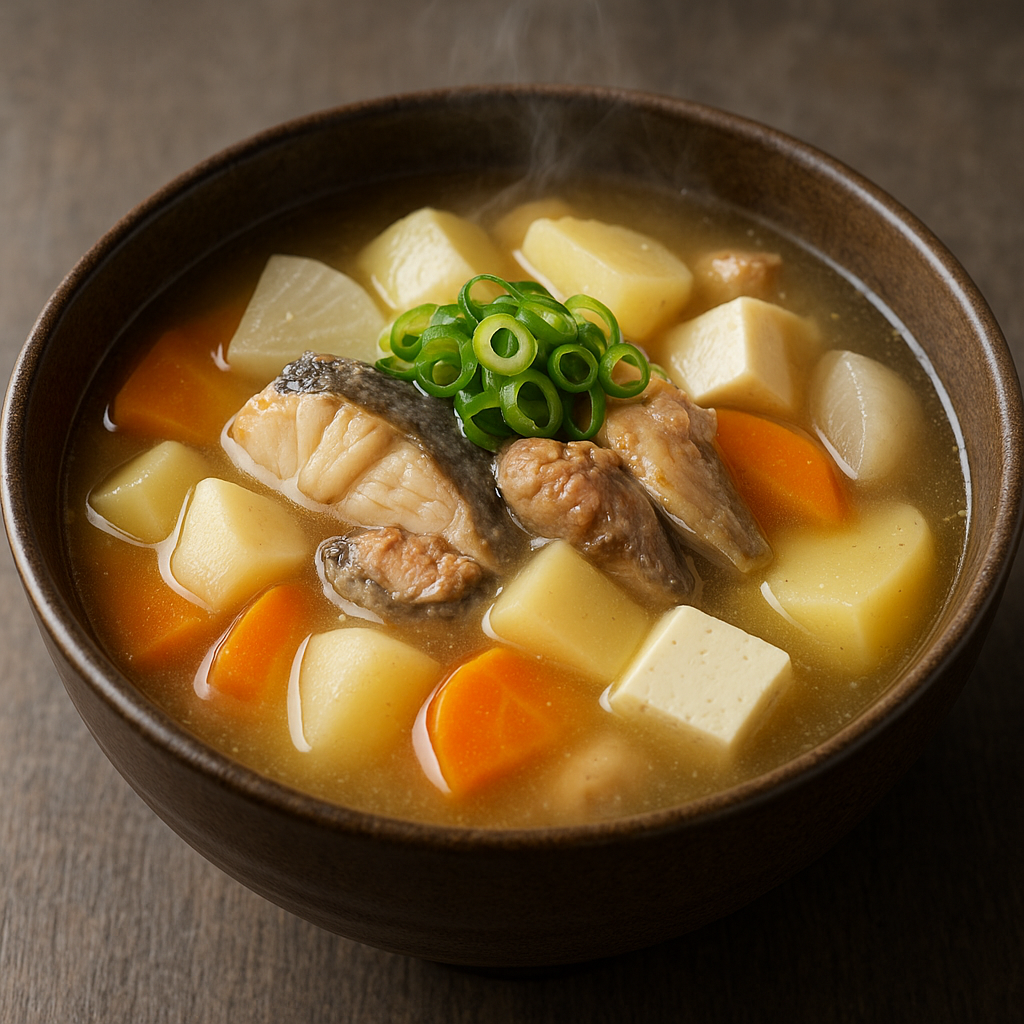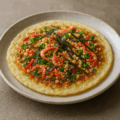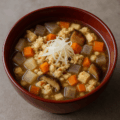どんこ汁(岩手)の特徴
肝のコクと骨の旨みを生かす、三陸の冬のあったか汁
どんこ汁は、三陸沿岸で親しまれてきた魚「どんこ」をぶつ切りにし、肝(きも)のコクを活かして味噌仕立てにする郷土の一椀です。骨から出るだしの深みと、肝を溶いたまろやかさが合わさり、寒い季節にからだの芯まで温まります。
味噌ベースに根菜と豆腐を合わせ、香味で引き締めます
大根やねぎ、豆腐・こんにゃくなどを合わせるのが定番です。仕上げに生姜の香りを添えると、魚の旨みがいっそう際立ちます。
どんこ汁(岩手) レシピ
材料(5人分)
- どんこ(下処理済み・ぶつ切り) … 2〜3尾(正味約500g)
- どんこの肝 … 適量(血・胆のう除去)
- 大根 … 200g(いちょう切り)
- 長ねぎ … 1本(斜め切り)
- 木綿豆腐 … 1/2丁(さいの目)
- 人参… 200g(いちょう切り)
- だし … 1,000ml(昆布+煮干し 目安)
- 味噌 … 60〜80g
- 酒 … 大さじ2
- しょうゆ … 小さじ1(風味の締め)
- 生姜 … 10g(すりおろしまたは薄切り)
- 塩 … 少々
作り方
- 1. どんこはうろこ・えら・内臓を除く。肝は血と胆のうを外して水でやさしく洗い、水気をふく。身は塩を少々ふり、熱湯→氷水にくぐらせて霜降りし、ぬめりと臭みを除く。
- 2. 鍋にだしを沸かし、大根・人参を入れて中火で7〜8分煮る。
- 3. どんこの身を加え、アクをすくいながら中火で5〜7分煮る。豆腐を加える。
- 4. 肝を包丁で叩いてペースト状にし、少量の酒と鍋の煮汁でのばす。鍋を弱火にしてこれを静かに入れて、ひと煮立ちさせる。
- 5. 火を弱め、味噌を溶き入れる。しょうゆで風味を締め、必要なら塩で調える。
- 6. 長ねぎ・生姜を加えてさっと温め、器によそう。
シェフのワンポイントアドバイス
- 肝は胆のうを必ず外す。苦味の原因になるため、破らないよう注意。
- 霜降りでぬめりと血を落とすと、だしが澄んで上品に仕上がる。
- 味噌は沸騰させない。弱火で溶かすと香りが活きる。
- どんこが手に入りにくい場合は、たら(真鱈)のぶつ切り+あんこうの肝で代用可。
栄養価(1人分の目安)
- エネルギー … 180〜260 kcal
- たんぱく質 … 15〜22 g(魚・豆腐由来)
- 脂質 … 5〜10 g(肝の量で変動)
- 炭水化物 … 8〜15 g(野菜・調味由来)
- オメガ3脂肪酸・ビタミンB群 … 魚・肝由来
歴史
浜のまかないから広がった、肝を活かす冬の汁です
三陸の冬場に水揚げされたどんこを、肝まで無駄なく使う知恵が家庭に根づきました。味噌仕立てにすることで体が温まり、栄養もとれます。
家庭の“我が家の味”として受け継がれてきました
根菜や豆腐・こんにゃくの組み合わせ、生姜の利かせ方、味噌の種類などに家ごとの工夫があり、行事や集まりの一椀として親しまれています。
English Version
Features of Donko Soup (Iwate)
A warming Sanriku winter soup using liver richness and bone-born depth
Donko soup features the coastal fish “donko,” cut into chunks and simmered in a miso base, with its liver blended in for mellow richness. The bones lend deep umami while the liver rounds the broth—perfect for cold weather warmth.
Miso-based with roots and tofu, brightened by ginger
Daikon, carrot, tofu, and green onion are classic partners. A touch of ginger at the finish sharpens and lifts the fish’s savory notes.
Donko Soup (Iwate) – Recipe
Ingredients (Serves 5)
- Donko (cleaned, cut into chunks) … 2–3 fish (net ≈ 500 g)
- Donko liver … as available (remove blood & gall bladder)
- Daikon … 200 g (half-moon slices)
- Carrot … 200 g (half-moon slices)
- Firm tofu … 1/2 block (diced)
- Long green onion … 1 stalk (diagonal slices)
- Dashi … 1,000 ml (kombu + niboshi, approx.)
- Miso … 60–80 g
- Sake … 2 Tbsp
- Soy sauce … 1 tsp (to finish)
- Ginger … 10 g (grated or thin-sliced)
- Salt … a pinch
Directions
- 1. Prep fish: remove scales, gills, and entrails. Separate the liver; remove blood and the gall bladder, rinse gently, and pat dry. Lightly salt fish pieces, blanch in boiling water, then shock in ice water (shimo-furi) to remove slime and odor.
- 2. Bring dashi to a boil; add daikon and carrot and simmer 7–8 minutes over medium heat.
- 3. Add fish pieces; skim scum and simmer 5–7 minutes. Add tofu.
- 4. Mince the liver to a paste; loosen with a little sake and hot broth. Lower heat and stir the liver mixture into the pot; bring just to a gentle simmer.
- 5. Reduce heat and dissolve in miso; finish with soy sauce and adjust salt.
- 6. Add sliced green onion and ginger; warm briefly and ladle into bowls.
Chef’s Tips
- Always remove the gall bladder from the liver to prevent bitterness.
- Shimo-furi (quick blanch → ice water) clarifies the broth and refines flavor.
- Do not boil after adding miso; low heat preserves aroma.
- If donko is hard to source, cod chunks plus a little monkfish liver give similar richness.
Nutrition (per serving, approx.)
- Energy … 180–260 kcal
- Protein … 15–22 g (from fish & tofu)
- Fat … 5–10 g (varies with liver amount)
- Carbohydrates … 8–15 g (from vegetables & seasoning)
- Omega-3s & B-vitamins … mainly from fish and liver
History
A winter bowl from the docks, making full use of the liver
Along Sanriku, families adopted thrifty methods to use donko completely, blending its liver into a miso soup for warmth and nourishment in winter.
Household variations endure
Root pairings, tofu and konnyaku choices, the amount of ginger, and the type of miso all vary by household, keeping this gathering-friendly soup a living home tradition.



何でも質問してください!